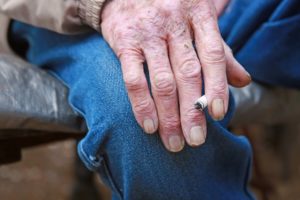 A recent study found that being a smoker, having diabetes, and also having a history of coronary heart disease or stroke increases the lifetime risk for PAD by as much as five times that of someone of the same race, age, and sex who does not have those risk factors. Additionally, race is a strong factor in PAD risk, contributing as much as some other health-related factors. The analysis was led by scientists at the Johns Hopkins Bloomberg School of Public Health and recently featured online in the Journal of the American Heart Association. According to the authors, the study is the first to have quantified the lifetime risk of PAD.
A recent study found that being a smoker, having diabetes, and also having a history of coronary heart disease or stroke increases the lifetime risk for PAD by as much as five times that of someone of the same race, age, and sex who does not have those risk factors. Additionally, race is a strong factor in PAD risk, contributing as much as some other health-related factors. The analysis was led by scientists at the Johns Hopkins Bloomberg School of Public Health and recently featured online in the Journal of the American Heart Association. According to the authors, the study is the first to have quantified the lifetime risk of PAD.
The investigators elaborate that the lifetime risk of lower-extremity peripheral arterial disease (PAD) is about 30% for black men and 28 percent for black women, with lower but still-substantial risks for Hispanics and whites.
The scientists analysed existing large datasets that include records of PAD tests and determined that lifetime PAD risk varies considerably by race, sex, age, smoking status, and the presence of other diseases such as diabetes. From their analysis, the researchers developed a risk calculator for identifying high-risk patients who might benefit from PAD diagnostic screening.
“A key finding in our study is that blacks have a significantly higher PAD risk than whites and Hispanics, even though current clinical guidelines don’t list race as a contributing factor,” says study lead author Kunihiro Matsushita, associate professor in the Department of Epidemiology at the Bloomberg School. “PAD clinical guidelines recommend considering the assessment of PAD among high-risk individuals, but our study highlights the importance of taking into account race in this context.”
The US Centers for Disease Control and Prevention estimates that about 8.5 million people in the USA have PAD, though about half have no symptoms. In general, the authors note, there is little public awareness of PAD compared to the awareness of other vascular conditions such as coronary artery disease and stroke.
The datasets used by Matsushita and colleagues for their analysis came from six community-based cohorts in the USA and included 38,154 people. These included long-running studies such as the Atherosclerosis Risk in Communities Study and the Framingham Heart Study. The health records in these datasets included a measurement called the ankle-brachial index (ABI), which is the systolic blood pressure at the ankle divided by the systolic pressure at the arm. An ABI of less than 0.9 is considered diagnostic for PAD.
Analysing the data from these cohorts along with US vital statistics on births, deaths and population, the researchers generated estimates for PAD lifetime risk by race and sex. Black men had the highest lifetime risk estimate at 30%, followed by almost 28% for black women. Hispanic men and women had estimated lifetime PAD risks of about 22 percent, while for white men and women the figures were about 19 percent each. The analysis suggested that about 9 percent of blacks develop PAD by age 60, while whites and Hispanics take another decade on average to reach that level.
Matsushita and colleagues applied further analytical techniques to their datasets to come up with a “calculator” to estimate the chance that someone has PAD based on race, age, sex, and health-related risk factors. Health-related factors again appeared to have an outsized impact on this probability. For example, according to the data, a 45-year-old black man, non-smoking and without diabetes or a history of cardiovascular disease or stroke would have just a 1.2% chance of having PAD whereas a 45-year-old black man with all of those risk factors would have a 10.5% chance of having PAD.
“Our PAD risk calculator algorithm can be used to select patients for screening with ABI tests and to guide the selection of treatments based on risk,” Matsushita says.
“Lifetime risk of lower extremity peripheral artery disease defined by ankle-brachial index in the USA” was written by Kunihiro Matsushita, Yingying Sang, Hongyan Ning, Shoshana H. Ballew, Eric K Chow, Morgan E Grams, Elizabeth Selvin, Matthew Allison, Michael Criqui, Josef Coresh, Donald M Lloyd-Jones, and John T Wilkins.













